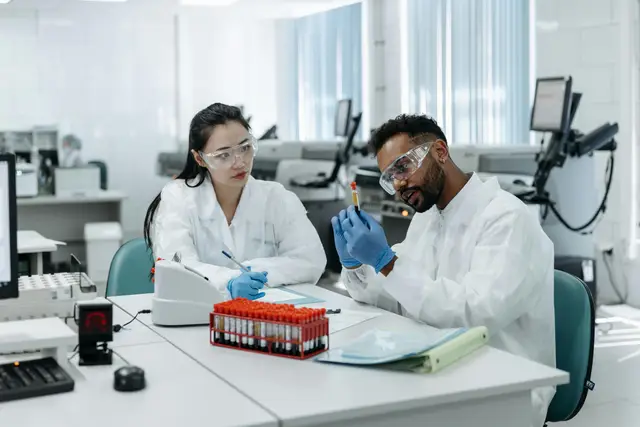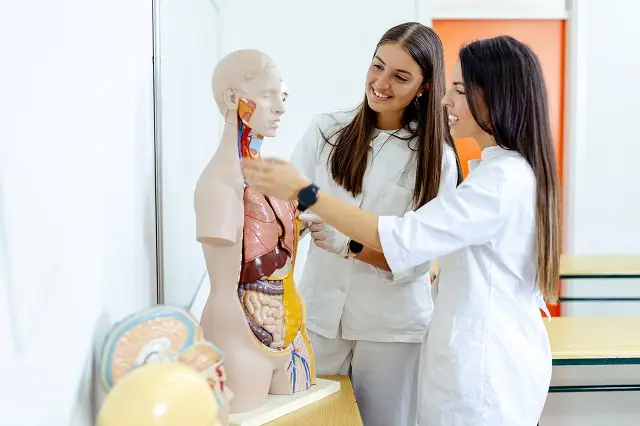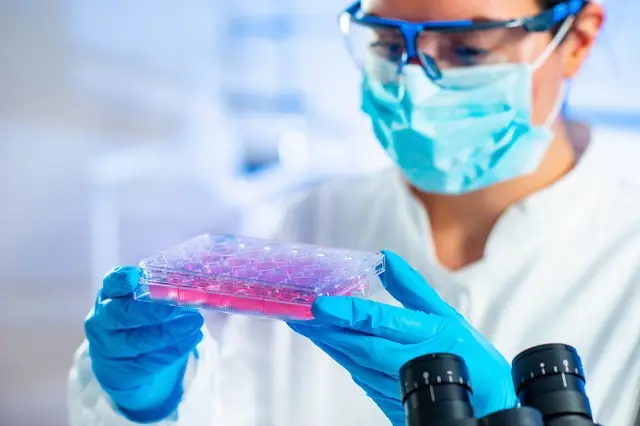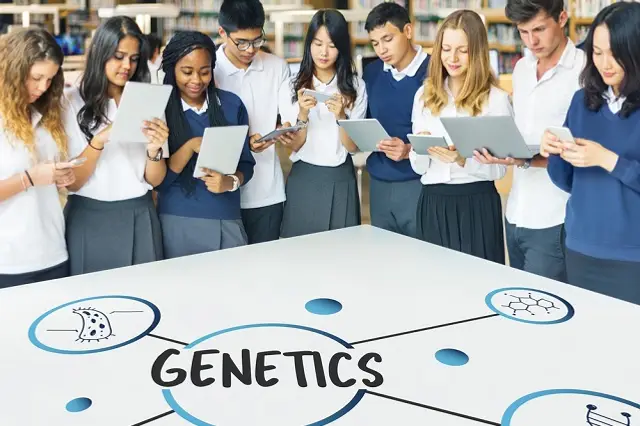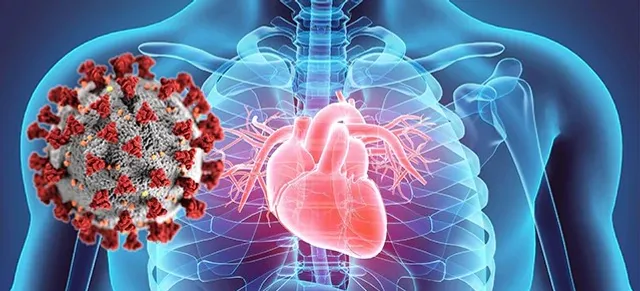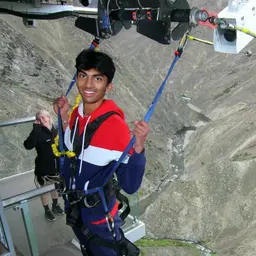Wanting a deeper understanding of life's complexities can lead you down many different roads in biological research and toward a variety of career options.
Let’s start with the physically tiny. Geneticists delve into the intricacies of DNA, studying heredity, genomics, and molecular mechanisms. Microbiologists investigate the world of microscopic organisms, probing bacteria, viruses, and fungi for insights into disease and ecological systems. Cell biologists unravel the complexities of cellular structure and function, providing foundational knowledge for medical breakthroughs.
On the other hand, biologists can also study ecosystems, populations, and entire species, examining the intricate relationships between organisms and their environments. Wildlife biologists focus on the behavior, distribution, and conservation of animal species in their natural habitats. Marine biologists explore the vastness of oceans, studying marine life and contributing to sustainable management of marine resources. Landscape ecologists analyze the spatial patterns of ecosystems, informing land-use planning and habitat restoration efforts. These careers often involve extensive fieldwork, data collection, and the application of ecological principles to address real-world challenges,
As you can see, biologists aren’t limited to wearing white coats in pristine laboratories. Field biologists venture into ecosystems like jungles, studying wildlife and contributing to conservation. Environmental biologists confront ecological challenges like climate change and experiment with sustainable practices. Agricultural biologists collaborate with farmers to enhance crop resilience. Bioinformaticians use computational tools to analyze biological data, while science communicators bridge the gap between research and the public. Whether in a lab, out in the field, at a computer, or engaging with the public, biologists and their findings can make a huge difference in the world.
Since you’re curious about living things, make a list of the phenomena that piques your interest the most. Then try to observe some of them and write down what you notice. Observation is one of the most valuable tools in a biologist’s toolkit. While biologists also employ advanced technologies and experimental techniques, the foundation of their work often begins with the power of attentive observation, enabling them to uncover patterns, relationships, and nuances. Beyond developing your own powers of observation, you will want to read up on your favorite subjects, preferably finding your reading material in scientific journals. Here are also some specific classes, books, and extracurriculars that can help you form a good foundation for a biology career.
1. Take a Class in High School
Biology and Chemistry - No matter which branch of biology you want to get into, these are the essentials. When given the option, consider taking the Advanced Placement (AP) or Honors version of these courses since they can offer more in-depth content and better prepare you for college-level coursework.
Environmental Science or Ecology - These courses provide insights into ecosystems, biodiversity, and conservation, which are crucial aspects of many biology careers.
Physics - Understanding the principles of physics can be beneficial, especially for biologists interested in biomechanics or physiological processes.
Algebra, Geometry, Pre-Calculus, and Statistics - Strong math skills are crucial for data analysis and modeling in biology. Statistical analysis is vital for interpreting biological data. A statistics course will enhance your quantitative skills.
Computer Science - Learning basic programming and data analysis skills is increasingly valuable in biological research.
Anatomy and Physiology: These courses offer a deeper understanding of the structure and function of living organisms, essential for various branches of biology.
English, Communication, and Public Speaking: Take any classes that enhance your ability to convey scientific ideas through writing and presentations.
If your school doesn’t offer one of these courses or you want to progress to more advanced levels, you could pursue a virtual version on Coursera, edX, MIT OpenCourseWare, or Khan Academy.
2. Read a Book
To find good biology books, focus on subjects you’re particularly interested in and check the author's credentials. Read reviews from reputable sources such as Scientific American, Nature, or The New York Times Book Review. Look for Pulitzer Prize or Royal Society of Biology Book Award winners. You can also find recommended reading lists on Goodreads or NPR, and try balancing popular science titles with works that specialize in your favorite subjects. Here are a few foundational books and a selection of more recent titles to get you started.
Foundational Texts:
On the Origin of Species by Charles Darwin (1859) - This seminal work laid the foundation for evolutionary biology. Darwin's observations and insights into the mechanisms of natural selection revolutionized our understanding of how species evolve over time.
Molecular Biology of the Gene by James D. Watson et al. (1965) - Co-authored by one of the discoverers of the DNA double helix, this classic text introduces the molecular basis of genetics, providing a fundamental understanding of how genetic information is stored and transmitted.
Silent Spring by Rachel Carson (1962) - While focused on ecology, Carson's work played a pivotal role in the environmental movement. The book addresses the impact of pesticides on ecosystems, particularly birds, and sparked increased awareness of environmental conservation.
The Diversity of Life by E.O. Wilson (1992) - Renowned biologist E.O. Wilson explores biodiversity, the interconnectedness of species, and the importance of preserving the Earth's rich variety of life forms.
More Recent Thought-Provoking Books:
The Hidden Life of Trees by Peter Wohlleben (2015) - Wohlleben, a forester, discusses the fascinating world of trees and forests. While not a traditional biology textbook, it provides insights into the interconnected lives of trees and the ecosystems they sustain.
Lab Girl by Hope Jahren (2016) - While partially autobiographical, Jahren's book combines memoir with botanical exploration, providing a personal and scientific account of her experiences as a geobiologist studying plants and soils.
The Code Breaker: Jennifer Doudna, Gene Editing, and the Future of the Human Race by Walter Isaacson (2021) - This biography explores the revolutionary CRISPR gene-editing technology and the ethical implications of manipulating the human genome.
Entangled Life: How Fungi Make Our Worlds, Change Our Minds & Shape Our Futures by Merlin Sheldrake (2020) - Sheldrake explores the fascinating world of fungi, revealing their crucial roles in ecosystems and their potential applications in various fields.
To supplement your reading and stay updated on the latest developments in the field, you should consider following reputable journals and news outlets, such as Nature, Science, Cell, The New England Journal of Medicine (NEJM), PLOS Biology, Trends in Ecology & Evolution (TREE), and Journal of the American Chemical Society (JACS).
3. Extracurricular Study
To get more hands-on experience and strengthen teamwork and problem-solving skills, you can seek out biology-related extracurricular activities such as these.
Science or Biology Club - Join or establish a science or biology club at your school to discuss scientific topics, conduct experiments, and collaborate with like-minded peers.
Nature or Environmental Club - Get involved in a club that focuses on environmental issues. This can involve activities such as conservation projects, tree planting, or participating in community cleanups.
Wildlife Conservation Volunteer Work - If you can’t find a club at school, you can always volunteer directly at local wildlife sanctuaries, nature reserves, or conservation organizations.
Botanical Gardens or Arboretum Volunteer - Learn about plant biology, conservation, and horticulture while contributing to the maintenance of these environments.
Animal Shelter or Zoo Volunteer - Volunteering at an animal shelter or zoo provides exposure to animal biology and conservation efforts. You may assist with educational programs, animal care, or habitat maintenance.
Beekeeping - If available, join a beekeeping club or start your own. Beekeeping offers insights into ecology, pollination, and the intricate lives of bees.
Biology research can involve intricate techniques, specialized equipment, and a nuanced understanding of experimental design. You don’t necessarily need a mentor, but having access to an experienced biology teacher, biologist, or researcher can help ensure that you are using proper methodology, interpreting data correctly, and abiding by ethical considerations. They can teach you practical skills, share insights into the scientific process, and help you navigate potential challenges. Here are ways to find a good biology research project and mentors you can work with.
Find research programs close to home
To find biology research opportunities close to home, check out our High School Student Research Opportunities Database. Click on your state, then search based on your location, institution, event type (in-person or virtual), and tuition (paid or free).
Work with a professor
If you have a clear project idea, you can reach out to professors in your field to see if they are open to collaborating with you. Refer to our Guide to Cold-Emailing Professors (written by Polygence literature research mentor Daniel Hazard, a Ph.D. candidate at Princeton University).
Engage in your own research project
You can absolutely undertake an independent biology research project. Start by identifying your interest, formulating a focused research question, and conducting a thorough literature review. Carly Taylor, a Stanford University senior who has completed several research projects this way, outlined a guide about how to write a self-guided research paper. By reading it, you’ll get a better understanding of what to expect when taking on this type of project. If you would like a little guidance and support, you can also choose to work with one of our Polygence biology mentors.
Enter a competition
The requirements and deadlines that competitions require you to meet provide a very helpful structure to keep your research moving forward. For some competition options, check out our post Top 10 Science Fairs and Competitions for High School Students in 2023. Another benefit to attending a competition is that you will meet other inspiring students, teachers, and even experts in the field you love most.
Here are some top picks for summer biology research programs.
1. Center for Talented Youth (CTY) Honors Biology
Hosting institution: Johns Hopkins University
Cost: $1,399
Format: Online
Application deadline: rolling admissions
This is an online research course where students will learn complex biological concepts in an online environment. It is great for students who are getting ready for AP biology. Students will explore the structures, functions, and processes of living organisms and their interactions with the environment. Students will be assessed through quizzes, tests, lab reports, interactive discussion forums and case studies. This course also provides monthly synchronous class times and gives students the opportunity to schedule one-on-one virtual meetings with the instructor.
2. Research Mentorship Program
Hosting institution: University of California at Santa Barbara (UCSB)
Cost: $11,299
Format: In person (Santa Barbara, CA)
Application deadline: Mid March
This program allows students to get exposure to a wide variety of interdisciplinary research in the biological sciences and beyond. Students will get a chance to engage in hands-on project-based learning and will also be paired with a research mentor - a graduate student, postdoc, or faculty member to conduct college-level research. Students can earn a total of 8 university credits by enrolling in two interdisciplinary research courses - an exploratory course and a lecture course. There are 24 different fields that students can choose from. Check the site for the most current application information.
3. Research in the Biological Sciences (RIBS)
Hosting institution: University of Chicago
Cost: $11,400
Format: In person (Chicago, IL)
Application deadline: TBD
RIBS is a four-week intensive program that exposes students to a broad range of topics within biology, including molecular, micro- and cell biological lab techniques. Students get hands-on “bench” research experience. This course is taught using a project-based approach and moves from a basic survey of lab techniques to more applied learning. Students who participate in RIBS will spend most of their days in the lab! Lectures and teaching material will also be provided to familiarize students with background knowledge and to introduce students to new ideas and concepts. Last but not least, students will participate in a research forum at the end of the course and everyone will get a chance to present their project results and findings.
For more, be sure to read our full list of Top Biology Summer Research Programs for High School Students post
Finding biology internships for high school students can be challenging due to factors like limited availability, competition, and institutional policies. Many research institutions prioritize college-level interns. Additionally, safety considerations may limit the number of opportunities for high school students. Some opportunities do exist, however, and it’s always worth checking out colleges in your area to see if they offer opportunities for qualified high school students. For our purposes here, we’re also including free long-term summer programs here as internships.
1. Pediatric Oncology Education (POE) Program
Hosting institution: St. Jude Children’s Research Hospital
Cost: Funded Internship
Format: In person (Memphis, TN)
Application deadline: Early February
This program offers highly motivated students a chance to get exposure to cutting edge cancer research. It also helps to prepare students for professions in the biomedical sciences, nursing, pharmacology, among other subfields that require oncology research experience and insight. Students will work with scientists, postdoctoral fellows, as well as research physicians. Check the site for the most current application information.
2. Summer Research Program (SRP)
Hosting institution: Indiana University’s Simon Cancer Center
Cost: None
Format: In person (Indianapolis, IN)
Application deadline: Early February
The Indiana University Simon Cancer Center Summer Research Program (SRP) aims to increase the proportion of underrepresented high school and undergraduate students engaging in the biomedical sciences. Students will receive hands-on experience and gain exposure to a wide range of basic science, translational, and clinical research activities. This is an 8-week program. High schoolers who are seniors as well as undergraduate students in their junior year and above are eligible to apply. Check the site for the most current application information.
3. Anson L. Clark Scholars Program
Hosting institution: Texas Tech University
Cost: None
Format: In person (Lubbock, TX)
Application deadline: February 13, 2023
This is a 7-week intensive program that offers selected students the chance to work with professors at Texas Tech’s General Health Sciences Center. This program is research-based, but it also exposes students to weekly seminars, discussion sections, as well as field trips. Check the site for the most current application information.
When brainstorming possible biology research projects, start with what you're into but also take into account what's practical. Can you get the gear and help you need? Is there a way you can connect your project with local issues, like the environment or community health? One big consideration: make sure the biology project is ethical, especially if it involves people or animals. Chat with teachers or mentors if you have doubts or concerns. The best projects fill in gaps in what we know and have a clear goal. Look into fresh areas like synthetic biology or epigenetics for something different. Avoid topics that are too big or have been done a lot, unless you've got a new angle.
Polygence Scholars Are Also Passionate About
Here are some ideas to get you inspired.
Efficacy of Marine Protected Areas
Marine protected areas (MPAs) are areas of ocean or coastal waters that are set aside for the conservation and sustainable use of marine resources. These areas are established by governments, NGOs, or other organizations, and they can take different forms, from fully protected "no-take" zones to areas with regulated fishing or other activities. Marine protected areas have the potential to guide sustainable resource management and protect biodiversity, but have a host of reasons for why they are not currently effective. Explore reasons for why MPAs may not be effective. Then develop a framework for mapping, modeling, and implementing an effective Marine Protected Area.
Idea by mentor Natalie
Bioinspiration: Do Animals Hold the Answers?
Can the toxins produced by frogs help us fight antibiotic resistant bacteria strains? How can understanding how lizards and newts regrow their limbs help us improve wound treatment? Why do tilapia skins help with burns? Discover the role of animals in the development of modern medicine as well as its potential. Are there any ethical concerns with these developments and findings? If so, what are they and do they matter? Share your findings in a research proposal, article, or presentation.
Idea by mentor Cheyenne
Height and Genetics: Nature or Nurture
How much do your genes determine your height? How much do nutrition and environmental factors play a role? What gene variants are implicated in height differences and what is the role of epigenetics? Epigenetics is the study of heritable changes in gene expression or cellular phenotype that occur without changes to the underlying DNA sequence. These changes can be influenced by diet and lifestyle. We will access and analyze an open dataset on twins to estimate the correlation between monozygotic twins (who have the exact same DNA) and height. You will learn to use R to open a dataset, analyze data with statistical methods such the student’s t-test, and display your data as graphs and charts. Finally, you will learn how to make a research presentation on height and genetics, describe the research methods, and present the data in a compelling and thorough way.
Idea by mentor Adeoluwa
Check out even more project ideas on the Biology Research Projects for High School Students: 20 Ideas To Try This Summer post.
You can also brainstorm your own project ideas based on what biological phenomena interest you. If you want help narrowing down your biology topic, the Pathfinders program gives you the chance to meet with three different mentors who specialize in your fields of interest. You can discuss your project ideas with them, and they can help you grow your idea, discover new research techniques, and point the way to great resources and alternative options.
Here are some inspiring biology projects done by some of our Polygence Scholars.
Keeping up with the Immortal T. Dohrnii Jellyfish
Lily wanted to know if humans might achieve immortality by studying the age-defying mechanisms observed in organisms like Hydra, Turritopsis dohrnii jellyfish, turtles, and lobsters. To find out, she researched telomerase enzyme activity, FoxO gene function, limitless cell regeneration, and cryptobiosis. She concluded that these mechanisms do present intriguing possibilities for human longevity. However, she also pointed out the impact that human immortality would have on our society. Lily also gave a live conference talk at the 8th Symposium of Rising Scholars where she won First Place for Best Talks.
Effects of Various pH Conditions on the Carbon Sequestration of Carex nudata
Polygence scholar Rock was interested in how the riparian sedge, Carex nudata, improves wetland health. Sedge plugs were grown under controlled conditions, with pH as the variable factor. Other abiotic conditions were held constant, and after a 14-day growth period, biomass and organic carbon measurements were taken. The conclusion revealed that C. nudata performed best in neutral pH conditions, providing insights into how pH affects different wetland species. This research contributes to the broader understanding of wetland ecosystems, aiding in environmental impact assessment, restoration strategies, and the overall health indication of wetlands. You can read Rock’s paper here.
An Examination of Habitability in Exoplanet Systems
There’s no such thing as Planet B. Or is there? Divya wanted to develop a metric for ranking habitable environments in the TRAPPIST-1 and Kepler-62 planetary systems. She looked at criteria such as sustaining liquid water, reasonable environmental conditions, and the presence of life-sustaining molecules. Using data from the NASA exoplanet archive and other sources, she evaluated planet radius, stellar radius, planet density, effective temperature (Teff), and equilibrium temperature (Teq). In her conclusion, she ranked planets based on habitability. She then compared the most habitable ones with Earth. You can watch her presentation here.
Check out all the biology research projects done by Polygence Scholars.
As you begin to plan your research and gather information, you can begin outlining your paper.
In biology research papers, there's often an emphasis on supporting claims with empirical evidence, such as experimental data or observations. The format commonly follows the IMRAD structure: Introduction (stating the research question or hypothesis), Methods (detailing the experiments done or research methods employed), Results (these are your findings that may include a statistical analysis, figures, and tables), and Discussion (where you interpret your results, address the hypothesis, and place the study in the broader context of existing research). Citations and references are also crucial to acknowledge existing research and provide context.
You will also need a concise and informative title and an abstract of the project. The abstract should succinctly summarize the purpose, methods, results, and conclusions of your study.
Here are a few places you can go to find good biology research papers for reference and to understand the format:
PubMed - A comprehensive database of biomedical literature, including biology research papers. It provides access to a wide range of journals and articles.
ScienceDirect - A leading full-text scientific database offering access to a vast collection of biology and life sciences journals.
Google Scholar - Provides access to scholarly articles, including many in the field of biology. It allows you to see how papers have been cited and find related articles.
JSTOR - A digital library offering academic journal articles, books, and primary source materials. It covers a broad range of disciplines, including biology.
Nature Journals - Journals like Nature and its affiliated publications often showcase high-impact biology research. They are valuable for understanding the format and style of top-tier research papers
If you need more general guidance overall, here’s a great article on how to write a good research paper. Also, if you have some ideas and want the support of a skilled expert, you can work with a Polygence biology mentor.
Once you’ve researched, written, and perfected your research paper, it’s time to introduce it to the world. You could enter it at a science fair or publish it in a journal. Publishing your research in a peer-reviewed journal can take the great work you’ve already done and add credibility to it. It also makes a stronger impression than unpublished research. The process of having your work reviewed by advanced degree researchers can be a valuable experience in itself. You can receive feedback from experts and learn how to improve upon the work you’ve already done.
Here are some publications you could look into.
1. The Journal of Emerging Investigators (JEI)
JEI is an online, peer-reviewed journal that publishes research by middle and high school students in various scientific disciplines, including biology. Please note that JEI requires that a teacher, mentor, or Principal Investigator of a lab submit your research on your behalf.
Cost: Free
Deadline: Rolling
Type of research: Original research in the biological and physical sciences written by middle and high school students.
2. Journal of High School Science
The Journal of High School Science is a peer-reviewed quarterly publication showcasing high school student research in the realm of science, technology, engineering, arts, and mathematics.
Cost: Free
Deadline: Rolling
Type of research: STEAM-based research or innovations by high school students.
Regarding getting your project accepted and published at these or any other peer-reviewed journal: Be prepared for the possibility of rejection or revisions. Scientific publishing is a competitive process, so maintain a positive attitude and be persistent in your efforts to improve and disseminate your research. (Quote from The Journal of High School Science website)
3. Research Archive of Rising Scholars
You can also showcase your work in The Research Archive of Rising Scholars (RARS), an open-access preprint archive for research articles written by young scholars, like you, from around the globe. Having your work circulated through RARS means that you’ll have a link to share with others so that they can read and engage with the research you’ve completed. Since this is a non-peer-reviewed preprint server, students who showcase their work on RARS can decide at any point to submit their work to a journal or competitions for consideration.









